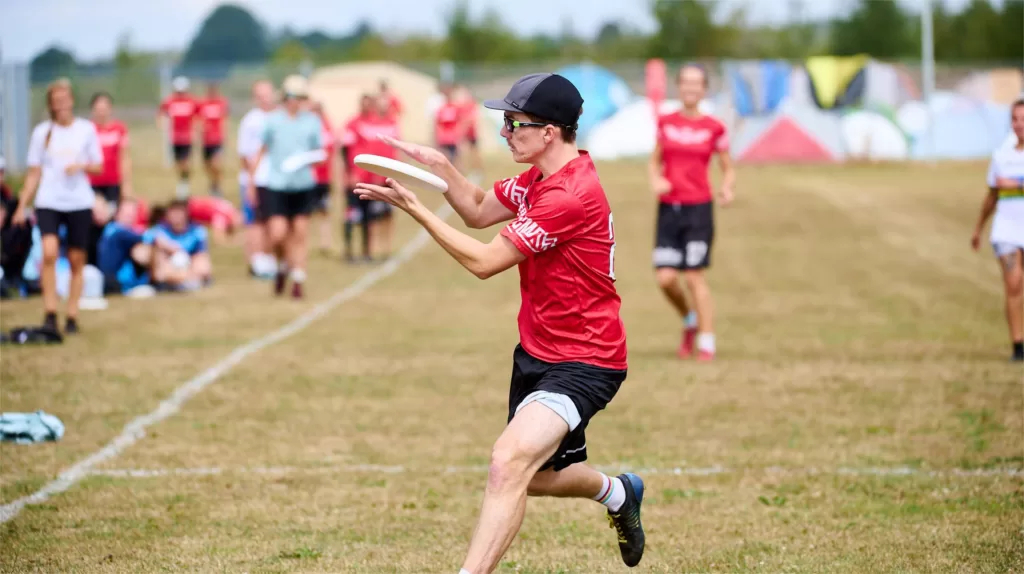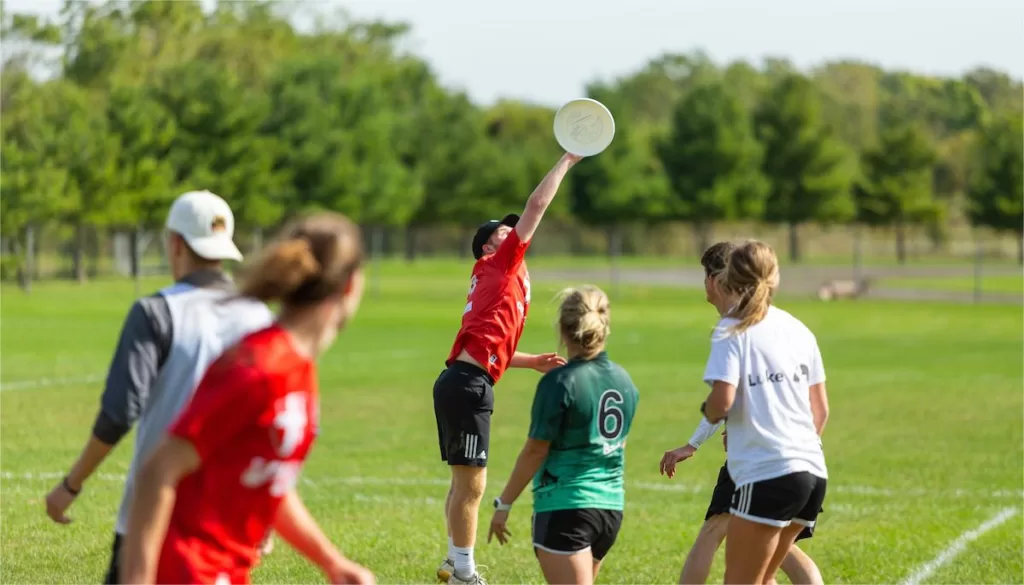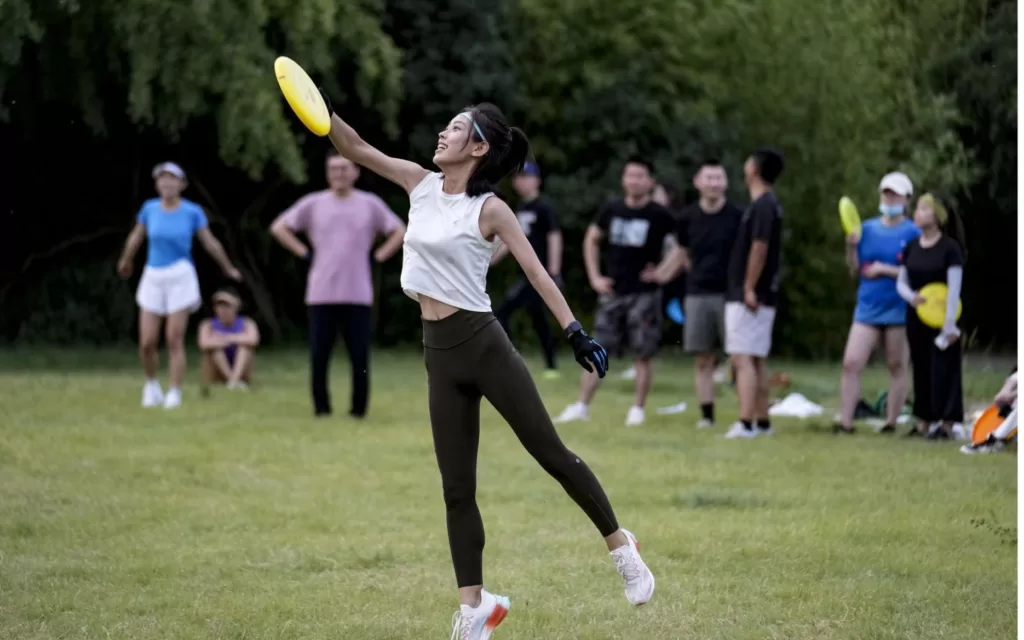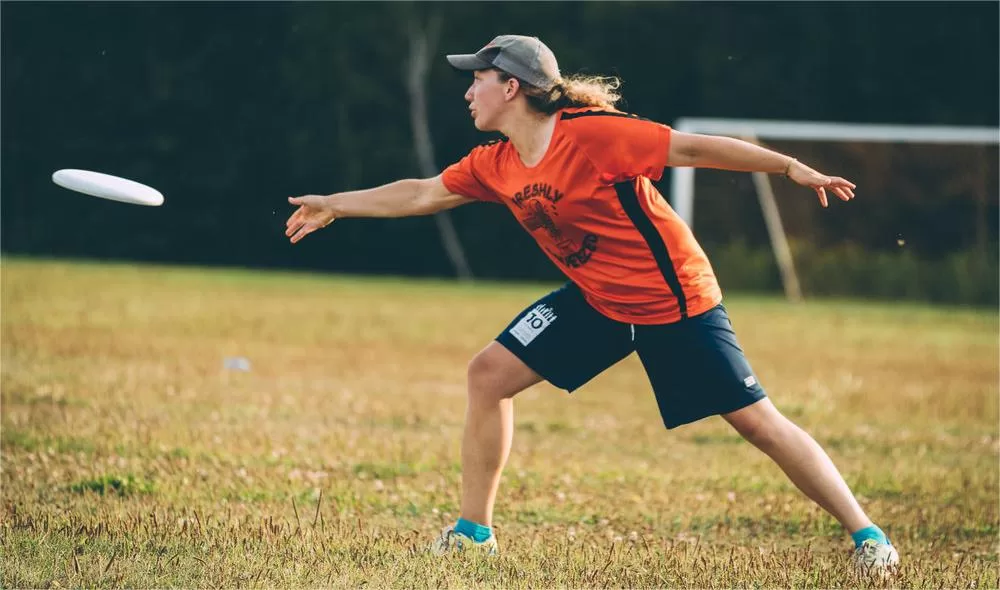Frisbee는 인기있는 야외 스포츠로 신체를 운동 할뿐만 아니라 반응과 조정을 향상시킵니다. 그러나 잘 플레이하려면 특정 기술뿐만 아니라 관심이 필요합니다. 이전 기사에서 우리는 소개했습니다 Frisbee의 비행 원리 및 통제. 이 기사에서는 Frisbee를 사용 하여이 스포츠를 더 잘 즐기는 데 도움이되는 팁과 예방 조치를 살펴 보겠습니다.

Frisbee의 기본 구조와 재료
디스크는 가볍고 얇거나 둥근 또는 육각형 스포츠 장비로 일반적으로 특수 플라스틱 재료로 만들어졌으며 때로는 폴리 우레탄, 고무, 실리콘 및 기타 재료를 사용할 수도 있습니다. Frisbee의 기본 건축 및 재료는 다음과 같습니다.
- 외부 구조 : 디스크의 모양은 일반적으로 원형 또는 육각형이며 중앙 영역과 림 영역으로 구성됩니다. 중앙 영역은 일반적으로 디스크를 잡고 던지는 오목한 원형 영역입니다. 림 영역은 디스크의 주요 부분이며 일반적으로 디스크의 회전과 글라이드를 제어하는 데 사용되는 얇은 가장자리가있는 평평한 고리 구조입니다.
- 재료 : 대부분의 디스크는 폴리 우레탄, 폴리에틸렌, 폴리 프로필렌, 폴리 카보네이트 등과 같은 중합체 재료로 만들어졌습니다. 이 모든 재료는 가벼운 중량, 강도 및 내구성의 장점을 가지고 있습니다. 또한 일부 고급 디스크는 탄소 섬유 및 케블라와 같은 고급 재료를 사용할 수 있으며,이 재료는 강도가 높고 내마모성이 향상됩니다.
- 내부 구조 : 디스크의 내부 구조도 중요하며 일반적으로 얇고 강한 플라스틱 플레이트로 구성되어 있습니다. “해골”디스크의 전체 구조를지지하고 변형 및 폴딩을 방지합니다. 골격은 고정되거나 제거 가능할 수 있으며, 탈착식 골격이 더 편리하고 교체 또는 업그레이드 될 수 있습니다. 물론, 공장의 폴리 우레탄 디스크는 한 조각으로 제조되며 훨씬 간단한 구조를 가지고 있습니다.
- 직물 : 직물은 일반적으로 디스크 표면에 추가되어 마찰과 그립을 향상시킵니다. 일반적으로 사용되는 직물에는 실리콘, TPU 등이 포함됩니다.
디스크를 올바르게 잡는 방법
디스크를 올바르게 유지하는 것은 디스크를 제어하고 던지는 데 매우 중요합니다. 다음은 디스크를 올바르게 고정하는 두 가지 일반적인 방법입니다.
- 손가락 그립 : 디스크를 손바닥에 넣고 림 영역을 색인과 중간 손가락으로 꼬집고 엄지 손가락을 똑바로 펴고 디스크에 눌렀습니다. 이 그립 방법은 장거리 디스크를 던지는 데 적합합니다.
- 손 그립 : 손의 손바닥을 열고 림 부위 주위에 손가락으로 손바닥 중앙에 디스크를 놓습니다. 이 그립은 더 짧은 거리에 디스크를 던지는 데 적합하며 디스크 방향을보다 쉽게 제어 할 수 있습니다.
디스크를 잡을 때 손이 디스크 표면에 단단히 달라 붙어 그립의 안정성을 높이십시오. 던질 때 팔의 힘을 사용하여 손목을 비틀지 않고 디스크를 밀어 넣으십시오. 또한 던지기에 디스크의 방향과 높이를 제어 할 수 있도록 디스크의 회전 방향에주의하십시오.
Frisbee의 올바른 크기와 무게를 선택하는 방법
디스크의 올바른 크기와 무게를 선택하는 것은 던지는 거리에 영향을 미치고 디스크를 제어하는 것이 얼마나 쉬운 지 매우 중요합니다. 다음 4 가지 제안이 여기에 제공됩니다.
- 크기 : 대부분의 frisbees는 직경이 7 ~ 10 인치입니다. 작은 디스크는 제어하고 던지기 쉽기 때문에 어린이와 초보자에게 더 적합합니다. 더 큰 디스크는 숙련 된 플레이어에게 장거리에 던져 질 수 있으므로 적합합니다.
- 무게 : 디스크의 무게는 일반적으로 100 ~ 200g입니다. 가벼운 디스크는 제어하고 던지기 쉽기 때문에 초보자에게 적합합니다. 더 많은 디스크는 숙련 된 플레이어에게 더 일관되게 비행 할 수 있고 제어하기 쉽기 때문에 적합합니다.
- 디스크 유형 : 다양한 유형의 디스크도 던지기의 용이성에도 영향을 미칩니다. 전통적인 디스크는 모든 종류의 플레이어에게 적합하지만 세련된 디스크는 더 매끄럽게 날 수 있지만 더 많은 기술과 경험이 필요합니다.
- 사이트 및 환경 던지기 : 사이트 및 환경을 던지는 것도 고려해야합니다. 실내 또는 바람이 부는 환경에서는 더 가벼운 디스크가 던지기에 더 좋습니다. 야외 또는 바람이 부는 환경에서는 무거운 디스크가 던지기에 더 적합합니다.
결론적으로 올바른 디스크 크기와 무게를 선택하려면스러워, 장소 및 환경의 기술 수준을 포함한 여러 요인을 고려해야합니다. 초보자는 더 작고 가벼운 디스크로 시작하여 다양한 던지기 환경과 요구 사항을 수용하기 위해 체중과 크기를 점차적으로 증가시키는 것이 좋습니다.
Frisbee의 기본 기술
Frisbee는 재미있는 활동이며, 플랫 플라잉, 던지기 및 잡기와 같은 기본 기술은 Frisbee 기술을 마스터하는 데 중요한 기초입니다. 다음은 이러한 기본 기술에 대한 자세한 설명입니다.
- 플라이트 플랫 : 플라잉 플랫은 가장 기본적인 프리즈 비 기술 중 하나입니다. 디스크의 가장자리 영역을 잡고 디스크를 공중에 유지할 수있을 정도로 디스크를 강하게 밀어 넣으십시오. 평평한 비행은 던지기가 적절한 힘, 각도 및 회전으로 디스크의 방향과 거리를 제어해야합니다.
- Up Throw : Up Throw는 디스크를 높이 던지고 회전시키는 기술입니다. 디스크를 가장자리 영역에 잡고 던지기는 팔과 손목 강도를 사용하여 디스크를 자연스럽게 회전시킵니다. UP 던지기는 던지기가 디스크를 꾸준히 회전시키고 결국 던지기의 손으로 돌아 가기 위해 올바른 힘과 각도를 갖도록 요구합니다.
- 잡기 : 캐치는 비행 중에 디스크를 잡는 기술입니다. 디스크가 땅에 부딪 치려고 할 때, 던지기는 팔과 손바닥의 강도로 디스크를 잡는다. 잡기 위해서는 던지기가 디스크를 성공적으로 잡을 수 있도록 좋은 타이밍과 정확도를 갖추어야합니다.
이러한 기본 요령 외에도 Frisbee에는 Sideway Flying, Backward Leaning 및 Sorizontal Roll과 같은 다른 많은 기술과 트릭이 있습니다. 이러한 속임수를 마스터하려면 기술 수준이 높고 연습이 더 필요하지만 Frisbee가 더 재미 있고 도전적으로 만들 수 있습니다. 트릭이 무엇이든, 던지기는 비행 중에 디스크의 방향과 높이를 제어하고 디스크 트릭에서 성공을 달성하기 위해 전력, 각도, 스핀 및 타이밍의 요소를 마스터해야합니다.
Frisbee가 지나가는 방법을 연습하는 방법?
Frisbee Passing and Catching은 Frisbee 기술 수준을 향상시킬뿐만 아니라 팀워크 및 조정을 향상시키는 매우 재미있는 활동입니다.
- 팀 구성 : Frisbee가 지나가고 잡는 연습을하려면 최소 2 명의 참가자가 필요하지만 바람직하게는 3 ~ 5 명이 필요합니다. 연습 효과에 영향을 미치지 않기 위해 너무 많은 사람이없는 것이 좋습니다.
- 연습장 결정 : 연습을 위해 열린 필드, 바람직하게는 잔디 나 해변과 같은 평평한 필드를 선택해야합니다.
- 올바른 디스크를 선택하십시오 : 참가자의 기술 수준에 따라 연습 목적에 따라 디스크의 올바른 크기와 무게를 선택하십시오.
- 통과 순서를 결정하십시오. A → B → C → A와 같은 통과 순서를 결정한 다음 연습을 시작하십시오.
- 디스크의 비행 높이와 속도 제어 디스크의 속도 : 통과 및 잡을 때 디스크의 비행 높이와 속도를 제어하여 수신기가 디스크를 정확하게 잡을 수 있도록주의하십시오.
- 의사 소통 및 조정 : 디스크를 성공적으로 통과하고받을 수 있도록 통과하고 잡을 때 좋은 의사 소통과 조정이 필요합니다.
- 난이도 증가 : 기술이 향상됨에 따라 패스 수를 늘리거나 패스 순서를 변경하거나 수신기 수를 늘리는 등의 난이도가 높아질 수 있습니다.
- 다른 기술과 결합하십시오 : 사이드 플라잉, 던지기 및 수평 롤링과 같은 다른 기술을 결합하여 통과 및 수신 연습을 더욱 흥미롭고 도전적으로 만들 수 있습니다.
이러한 단계를 통해 참가자는 프리즈 비 통과 및 잡기를 연습하고 Frisbee 기술을 지속적으로 향상시킬 수 있습니다. 또한 팀워크와 의사 소통 기술을 향상시키고 스포츠의 재미와 기쁨을 느끼게하는 매우 재미있는 활동입니다.

Frisbee의 비행 환경 및 안전 예방 조치
Frisbee는 재미있는 스포츠이지만 비행 중에는 자신과 다른 사람들을 안전하게 지키기 위해 환경과 안전 문제를 알고 있어야합니다.
- 비행 환경 : 비행 현장을 선택할 때는 공원, 잔디, 해변 등과 같은 열린 사이트를 선택해야한다는 사실에주의를 기울여야합니다. 군중이나 교통 흐름이 높은 곳에서 날아가는 것을 피해야합니다. 실내에 비행 할 때는 사이트의 크기와 장애물의 존재에주의를 기울여야합니다.
- 안전 거리 : 비행시, 다른 사람이나 장애물과의 충돌을 피하기 위해 안전한 거리를 유지해야합니다. 일반적으로, 5 미터 이상의 안전한 거리는 유지해야합니다. 또한 불필요한 간섭이나 프리즈 비 손상을 피하기 위해 강한 바람이나 악천후로 날아가는 것을 피해야합니다.
- Frisbee를 잡고 : Frisbee를 잡을 때 포핸드 그립 또는 백핸드 그립과 같은 적절한 그립을 선택해야합니다. 그립 강도는 비행 효과에 영향을 미치지 않도록 너무 빡빡하거나 느슨하지 않아야합니다.
- 비행 자세 : 비행 자세와 관련하여 신체의 균형을 유지해야합니다. 디스크의 대상 방향을 향한 디스크를 유지하고 부상이나 피로를 피하기 위해 편안한 자세를 유지해야합니다.
- 잡기 기술 : 디스크를 잡을 때는 어획 위치에주의를 기울이고 디스크 자세를 잡아야합니다. 잡기 위치는 디스크의 비행 경로에 있어야하며 디스크를 잡을 때 손을 열어 디스크의 중앙을 잡고 디스크가 흘러 나오거나 손상되지 않도록합니다.
- 위험한 행동을 피하십시오 : 비행 중에는 낙상이나 다른 위험한 사건을 피하기 위해 점프 및 땅에 떨어지는 것과 같은 위험한 행동을 피하십시오.
요컨대, Frisbee를 플레이 할 때는 환경 및 안전 문제에주의를 기울이고 가능한 한 많은 비행을위한 안전한 사이트를 선택하고 적절한 거리와 자세를 유지하며 위험한 행동을 피해야합니다.
Frisbee 게임을하는 방법
Frisbee 토너먼트는 게임의 공정성과 안전을 보장하기 위해 특정 조건을 충족시키고 규칙 및 안전 요구 사항을 준수해야합니다. 이런 식으로 만 우리는 더 나은 프리즈 비 토너먼트를 가질 수 있습니다.
- 토너먼트 시스템 : 프리즈 비 토너먼트는 일반적으로 싱글과 팀의 두 가지 유형의 토너먼트로 나뉩니다. 싱글 플레이어 토너먼트에서 플레이어는 지정된 시간 내에 디스크를 여러 번 던져야하며 점수가 가장 높은 플레이어가 승리해야합니다. 팀 경쟁은 두 가지 모드로 나뉩니다. 여러 플레이어는 교대로 디스크를 던지고 여러 플레이어는 동시에 디스크를 던지고 규칙과 점수에 따라 승자를 결정합니다.
- 장소 : 경쟁 장소는 평평하고 개방적이며 장애물이없는 특정 조건을 충족해야합니다. 경기장은 농구장, 축구장 등과 같은 표준 스포츠 분야를 사용할 수 있습니다. 게임의 규칙에 따르면, 점수를 판단하고 위반을 피할 수 있도록 필드를 표시해야합니다.
- 규칙 : Frisbee 경쟁의 규칙에는 일반적으로 게임 시간, 점수 방법, 위반 및 기타 측면이 포함됩니다. 플레이어는 지정된 시간 내에 게임을 완료하고 규칙을 따라 디스크를 던지고 디스크 및 기타 작업을 잡아야합니다. 스코어링 방법에는 디스크를 지상에 던지고 디스크를 잡는 디스크, 거리 점수 등이 포함됩니다. 위반에는 선을 넘어서 디스크를 던질 때 잘못된 위치에 서, 디스크 던지기 과정에서 다른 위반 등이 포함됩니다.
- 심판 : 프리즈 비 토너먼트는 특별 심판이 감독하고 판사해야합니다. 심판은 플레이어의 위반을 판단하고 점수를 계산하고 계산해야합니다. 심판은 게임의 공정성과 합리성을 보장하기 위해 심판에서 풍부한 경험과 기술이 필요합니다.
- 안전 : 경쟁 중에 플레이어는 사고를 피하기 위해 안전에주의를 기울여야합니다. 경쟁 장소는 안전을 표시하고 상기시켜야하며, 플레이어는 경쟁 규칙을 준수하고 위험한 행동을 자제해야합니다.
신체를위한 프리즈 비 운동
Frisbee는 다재다능한 스포츠이며 신체에 대한 운동 효과는 매우 중요합니다. 근육을 운동하고 심장 박동 기능을 향상시킬 수있을뿐만 아니라 조정 및 반응 능력을 향상시켜 매우 좋은 운동입니다.
- 운동 팔과 어깨 : 디스크 스포츠는 팔과 어깨를 사용하여 디스크 던지기와 어깨를 완성하고 팔과 어깨의 힘과 지구력을 행사해야합니다.
- 운동 핵심 근육 : 디스크 스포츠는 신체 균형과 조정을 유지해야하며 복부 근육, 허리 근육 등을 포함한 핵심 근육을 운동 할 수 있습니다.
- 운동 다리 근육 : 디스크 스포츠는 달리기, 점프 및 기타 움직임이 필요하며 허벅지 및 송아지 근육을 포함한 다리 근육을 운동 할 수 있습니다.
- 심장부 자막 기능 향상 : Frisbee는 오랜 기간의 달리기, 점프 및 기타 활동이 필요하므로 심장 박동 기능을 향상시키고 신체의 지구력을 향상시키고 힘을 유지할 수 있습니다.
- 조정 및 반응 능력 향상 : Frisbee는 고속 운동과 빠른 반응이 필요합니다. 다른 활동은 조정 및 반응 능력을 향상시키고 신경계의 발달을 촉진하며 반응 속도를 향상시킬 수 있습니다.
디스크를 관리하고 유지하는 방법
디스크의 관리 및 유지 보수는 삶을 연장하고 좋은 성능을 유지하는 데 매우 중요합니다. 적절한 보관, 청소, 유지 보수 및 방울 및 장기 압력을 피하는 것은 디스크의 관리 및 유지 보수의 열쇠입니다.
- 저장소 : 디스크가 사용되지 않으면 시원하고 건조한 장소에 저장해야하며, 디스크 재료가 변형이나 손상을 방지하기 위해 햇빛과 고온 환경에 긴 노출을 피해야합니다.
- 청소 : 디스크는 먼지와 모래를 피하고 성능에 영향을 미치지 않도록 사용한 후 청소해야합니다. 물과 부드러운 천을 사용하여 비눗물을 닦거나 사용하여 청소하지만 산성 또는 알칼리성 세제를 사용하지 않을 수 있습니다.
- 유지 보수 : 정기적으로 디스크의 가장자리에 균열이나 손상이 있는지 확인하십시오. 문제를 발견하면 서비스 수명과 성능에 영향을 미치지 않도록 제 시간에 수리 또는 교체해야합니다.
- 떨어지지 않으면 : 디스크를 사용할 때는 디스크의 손상을 피하기 위해 복잡한 물체를 떨어 뜨리거나 치지 마십시오.
- 장기간 압력을 피하십시오 : 디스크에 장기간의 압력을 피하기 위해 디스크에 무거운 물체를 넣지 마십시오. 변형이나 손상을 유발하십시오.
프리즈 비 문화 및 사회 활동
Frisbee Culture and Social Activity는 사람들의 삶을 풍요롭게 할뿐만 아니라 인간의 관계와 이해를 촉진하는 즐거운 의사 소통과 엔터테인먼트를 제공합니다.
- Frisbee Social Events : Frisbee 토너먼트와 훈련은 종종 많은 Frisbee 애호가들이 모여 함께 모여 기술을 교환하고, 경험을 공유하며, 우정과 신뢰를 촉진 할 수 있습니다.
- 디스크 음악 축제 : 일부 도시와 지역 사회는 종종 디스크 음악 축제를 개최하여 많은 디스크 애호가와 음악 팬을 끌어 들이기 위해 참여합니다. 이 행사에는 일반적으로 Frisbee 대회, 음악 공연, 미술 전시회 및 푸드 부스가 포함되어 사람들이 음악을 즐기고 Frisbee를 연주 할 수있는 기회를 제공합니다.
- Frisbee Culture and Art : Frisbee는 스포츠 일뿐 만 아니라 문화와 예술이기도합니다. Frisbee 공연은 단일 공연, 듀오 공연 및 그룹 공연 양식을 포함한 다양한 기술과 움직임을 통해 Frisbee의 아름다움과 우아함을 보여줄 수 있습니다.
- Frisbee Travel : Frisbee 애호가들은 새로운 Frisbee 문화를 탐험하고 다양한 Frisbee 활동을 경험할 수 있습니다. 예를 들어, 국제 Frisbee 토너먼트에 가서 전 세계의 Frisbee 애호가와 상호 작용하거나 세계의 아름다움을 탐구하고 Frisbee 활동에 적합한 장소를 찾을 수 있습니다.

결론
Frisbee의 스포츠에 참여하면 신체적, 정신적 이점, 조정, 반응 및 전반적인 체력을 향상시킵니다. 그러나이 활동을 완전히 즐기고 뛰어나려면 올바른 지식과 기술을 갖추어야합니다. Frisbee의 인기가 커짐에 따라 기술 개발, 동지애 및 스포츠의 기쁨을 소중히 여기는 문화를 육성하는 것이 필수적입니다. 당신이 초보자이든 노련한 선수이든, 지속적인 학습과 연습은 Frisbee의 세계를 마스터하는 열쇠입니다.

